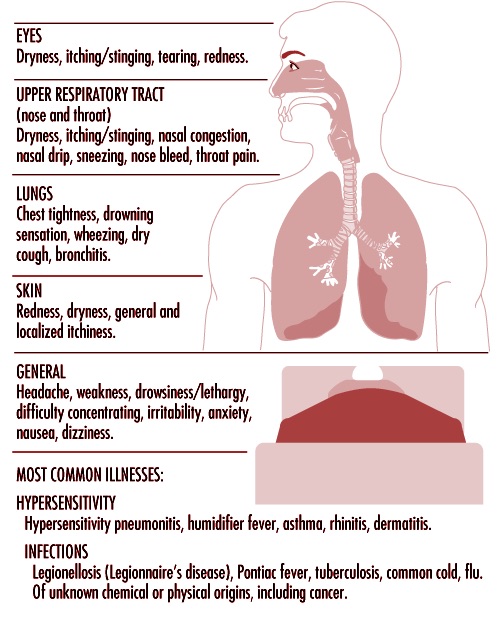Poor indoor air quality (IAQ) is an important health and safety concern. Several well-identified diseases and chronic illnesses have been traced to specific IAQ-related problems. Sometimes certain symptoms can be useful indicators of exposure to poor IAQ, especially if onset appears after:
- moving to a new residence;
- starting a new job or relocating office spaces;
- remodeling or refinishing a residence;
- bringing in new furniture or other furnishings;
- experiencing construction at work;
- weatherizing a property;
- using certain household and hobby projects products, or
- treating a residence with pesticides.
Symptoms of Exposure to Poor IAQ
In general, the following symptoms are often linked to exposure of poor IAQ:
- dryness and irritation of the eyes, nose, throat, and skin;
- headache;
- fatigue;
- shortness of breath;
- hypersensitivity and allergies;
- asthma attacks;
- sinus congestion;
- coughing and sneezing;
- dizziness;
- nausea;
- aggravated or worsened existing illness; and
- feeling noticeably healthier outside.
If you think that you have symptoms that may be related to your home or work environment, discuss them with your doctor or your local health department to examine if they are a result of exposure to poor IAQ. You may also consider consulting a board-certified allergist or an occupational medicine specialist who can recommend personal and environmental testing.

Common symptoms of exposure to poor IAQ
Signs of Exposure to Poor IAQ
In addition to tracking symptoms of exposure, you may also be able to identify IAQ-related problems by looking at your everyday environment, lifestyle, and activities. In general, the following signs are often linked to exposure of poor IAQ:
- unusual, fowl, and noticeable odors;
- stale, musty, or stuffy air;
- a distinguishable lack of air movement;
- damaged flue pipes and chimneys;
- unvented combustion air sources for gas-fueled space heaters, gas-fueled furnaces, charcoal grills, gas-fueled
- ranges, portable kerosene heaters, and wood stoves;
- excessive moisture and humidity;
- water-damaged walls, ceilings, and carpets; and
- the presence of active molds and mildew.
NOTE: The best way to detect indoor odors is to step outside for a few minutes, and then upon reentering the property, note if there are noticeable odors.
Of particular importance is looking for visible signs of problems with a property’s ventilation. In addition to some of the signs listed above, look for the following as an indication of inadequate ventilation:
- moisture condensation on windows or walls;
- dirty central heating and air cooling equipment;
- deferred maintenance related to the HVAC system; and
- and areas where books, footwear, cupboards, or other items become moldy.
If an inadequate amount of outdoor air enters an indoor space, pollutants can accumulate to levels that pose health, safety, and comfort problems.
If you or anyone you know suspect exposure to indoor air pollution an effort should be made to identify and remove the source. Sometimes treatment for IAQ-related problems is simply eliminating exposure to the source of pollution. IAC2 Certified Consultants are trained in the areas of IAQ and can perform specialized environmental testing to help you identify potential sources of pollution.

